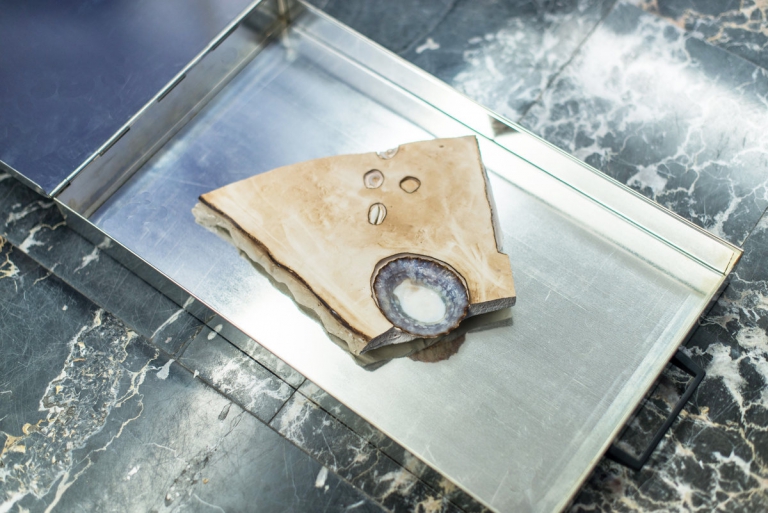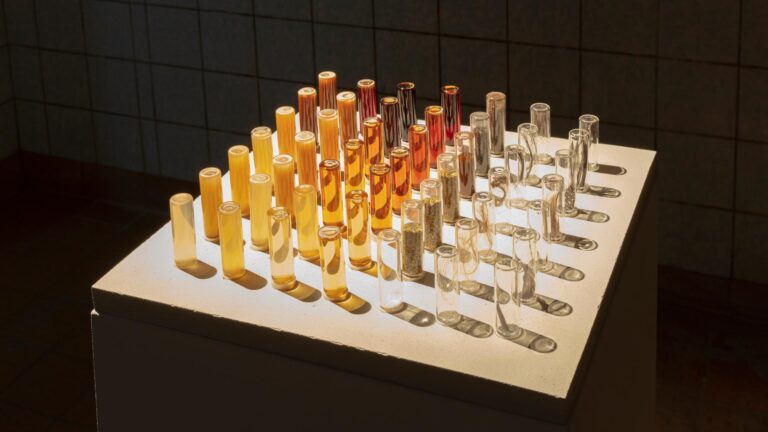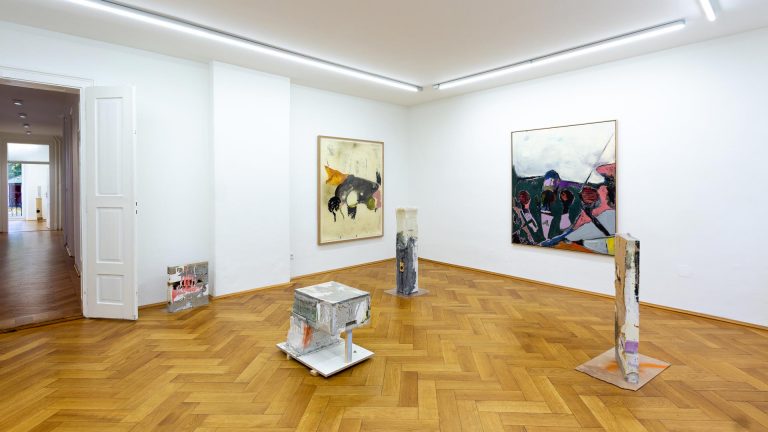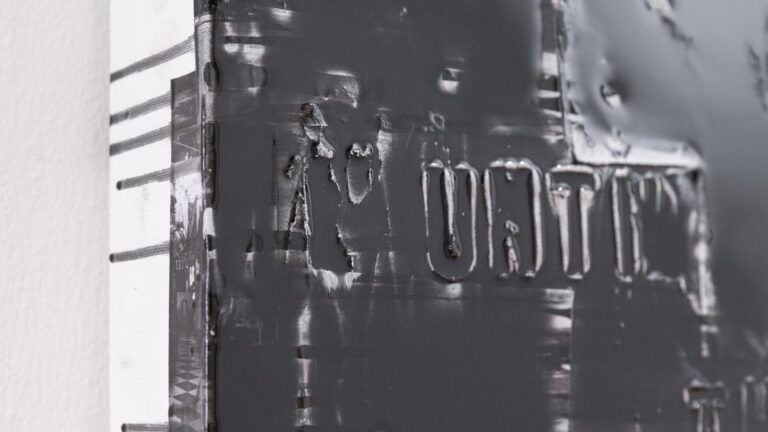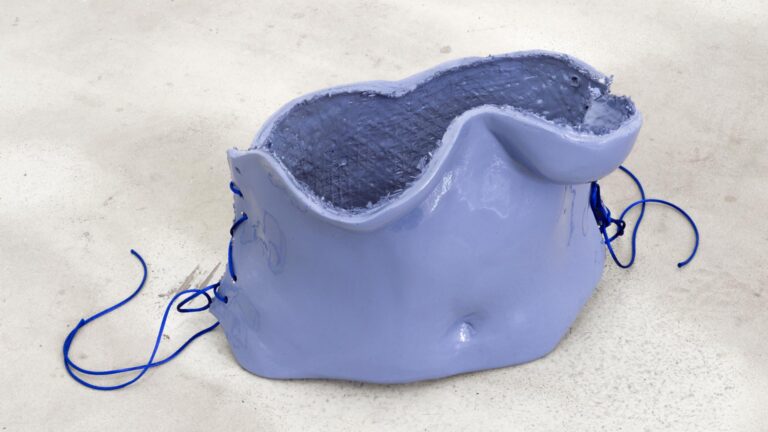Artist: Aldo Mondino
Exhibition title: Rules for Illusion, Part 1
Venue: Eden Eden, Berlin, Germany
Date: April 29 – September 19, 2015
Photography: images copyright and cortesy of the artist and Isabella Bortolozzi, Berlin
RULES FOR ILLUSION
Alberto Fiz
We must first and foremost clear away any grounds for misunderstanding. Aldo Mondino is one of the most important figures on the post-war art scene. An assertion that many might think taken for granted, in view of the complexity of his artistic experience carried out without interruption for almost half a century. Yet that is by no means the case, and many have preferred not to take a stance in the matter, using his light touch, his irony and his undoubted unconventionality as an alibi to define a non- conformism not immediately comprehensible with respect to the experiences of the neo-avant-gardes. Today, three years after his death, the notion of Mondino as a lightweight, which has been comfortably assumed by many critics, must be consigned to the archives by the acceptance of a broader vision of the history of art, one that cannot be sectarian or dogmatic.
In any case, maybe what he has not been forgiven for is having conducted his artistic researches as an outsider, without ever searching for shores on which to make landfall.
Although he was active in the environment, which led to the birth of Arte Povera, Mondino made a radical refusal of an evolutionistic interpretation of art, and his position far in a way preceded the crisis of ideologies. But this did not prevent him from availing himself of the playful side of the Conceptualist venture, an attribute he shares with Pino Pascali, Piero Manzoni and his bosom friend Alighiero Boetti, to whom in the year of the latter’s death (1994) he dedicated an important cycle of works.
Starting in the early 1960s, Mondino rejected a procedure that favoured the mental as opposed to the “making” aspect of art. The two components, in his opinion, could in no way be separated, because of the risk of producing a fundamentally tautological and repetitive type of art. He did not concede even a severance from the traditional media, painting and sculpture, which in spite of numerous divagations remained the chief domains in which Mondino was to operate.
Whatever he does, his work should be read as a homeopathic antidote tending towards a fresh meaning of the aesthetic organism in a genuinely post-modern key. There is no neutrality in it, but rather the urgency of an act aimed at provoking amazement and bewilderment in the observer.
His way was one of conscious opposition that favours paradox as the only accepted form in the context of permanent creative dissent.
Mondino is a rebellious and basically anarchic artist, who uses his art as a tool for subverting verbal and visual logic.
In this sense the living body of the work of art, in continual mutation, is caught in all its vulnerability. There is no apriority of style, but rather the will to initiate a process of misappropriation, which enables the artist to work out the direction of his understanding.
Right from the start Mondino rejected any sociological hypothesis of the identity of art with life, and worked upon the already codified instruments, which the history of art had provided for manipulation. As Enrico Crispolti wrote in 1963 on the occasion of Mondino’s one-man show at the Galleria Il Punto in Turin, “the symbols and emblems have shed their abstract nature as ideological themes and become concrete organic elements”.
If American Pop Art sublimates the objects of mass society and thereby creates new fetishes, Mondino works in the opposite way. What appears conventionally “museumified” is returned into circulation by the acceptance of a metamorphic principal.
There is no iconoclastic urge or wish to stir up scandal on the basis of certain mistaken interpretations of his works, but, if anything, the need to dismantle the existing linguistic codes and bring about a fresh approach in which the work reverts to the status of a sign in order to regain a newly central position.
In this way the language of Giuseppe Capogrossi is taken apart, planting a seed of doubt about the construction of his famous ideograms. The way the public is encouraged to identify the differences inherent in the modules presented by the informal artist, as Mondino does, is a philologically correct way of playing the game. Anyway, it is Capogrossi himself who complains of being treated too superficially. In 1968 he wrote: “What saddens me most is the banal question often put in good faith and tones of commiseration: ‘but you still go on working with the same ‘fork’, and they also call it ‘comb’, ‘trident’, ‘hand’, ‘cockroach’…”.
Mondino relieves him of this trouble, and does the same for Felice Casorati by using (1964) one of his most important icons (Maternità con le uova) as the subject of a series of works presented at the Galleria Sperone in Turin.
What for the Master was the pictorial emblem of purity and intellectual perfection became the occasion for appropriation and inversion of meaning, with the work reproduced on a mat along with the contradiction in terms “Non calpestar le uova!” (Don’t tread on the eggs) which in other circumstances can change into its apposite, “Calpestar le uova!”, as indeed it does in a mosaic of many years later.
This ambivalence was lucidly defined by Maurizio Fagiolo Dell’Arco in 1966 on the occasion of a show at the Studio Marconi in Milan: “The presence of the element of play is indubitable, but indubitable also is the continual duality of these images. Mondino always tends to refill what seemed shut up, to reopen perspectives that seemed inevitably at vanishing point, in an unending reversal of alliances”.
A work of art is always a manufactured article waiting to be authenticated by the kleptomaniac artist, prepared to lay hands on any image in order to modify its ultimate destiny.
The results that emerge are, according to Harold Rosenberg’s definition, anxious objects, which take on new meanings by shedding their inertial aspect. The idea of making tabula rasa, entertained in Utopian fashion by the avant-gardes, is replaced by the nomadic desire to manipulate the rules of art at will by applying a horizontal as opposed to vertical vision, one which in fact anticipates the poetics of the 1980s.
What had seemed to have been permanently relegated to the archives of history was recovered from the dusty shelves and put back into circulation by a deviating and deviant route that has nothing to do with the serialization of objects championed by Andy Warhol.
For Mondino the contemporary spirit resides in a principle of delocalization but certainly not of globalization, in which the databank of images may be scattered at will without any programmatic scruples, while pursuing a vision of the work that is relativistic and genuinely open to doubt. That said, his conceptual criteria were clearly present in his approach to art as early as 1965, when the subject- object of the representation is identified as the pictorial sign.
If for Giulio Paolini it is the linguistic instruments, which enter the scene, in Mondino’s case it is the outcome, which is identified, in its specific objectivation.
From the object-picture he moves to the object painting, with the brushstroke taking on an importance of its own on the canvas as a constant reminder of the physical nature of the material.
We need only to think of the meditation on the medium of painting that in 1965 induced Mondino to show the series of “Cadute”, “Bilance” and “Palloncini” at the Stein Gallery in Turin. What interests him is the structural component that triggers a mechanism of change.
His aim is to transform painting into a physical experience by using pigment as if it were a raw material, on a level with bundles of sticks or straw. For Mondino the point of reference is the nature of art, and in this respect he moves parallel with Gilberto Zorio and Giovanni Anselmo with regard to concepts such as weight, tension and balance. What he achieves is a meta-artistic operation, and his targets are Clyfford Still and Joseph Albers, two fully recognized and recognizable artists. Their works are violated by means of a procedure of subtraction, in which Still’s colouring scheme takes on an enigmatic appearance due to the reversal of some of its parts, while Albers’s square within a square is reproduced by transforming the geometrical structure into a staircase that reaches the ground which is nothing other than the work turned upside down.
But the painting, with all its load of history and symbols, can be easily hung up with clothes pegs as if it were washing, or made to levitate attached to the string of a balloon.
Five years had passed since 1960, when Piero Manzoni displayed his balloons blown up with artist’s breath, the famous “Corpi d’aria”, and Mondino returns to this idea. But he does so in order to carry the painting up high and liberate it romantically from its normal setting, joking about the conceptual tautology and rejecting the notion of dematerialization, which on the contrary was very much there in Manzoni’s case.
In 1967 comes another emblematic work, the “Torre di Torrone” (Nougat Tower) especially created for a one-man show at the Galleria Torre in Turin. Mondino creates a structure reminiscent of the Tower of Babel, symbol of the confusion of languages, with indirect reference to Pieter Breugel’s masterpiece “The Tower of Babel”. But this sophisticated work is constructed of ephemeral material and the bricks are bars of Piedmontese nougat, which result in the sort of visual contradiction that is characteristic of all Mondino’s work. Art is a hallucination that has the appearance of truth, an optical reflex which considers fiction as an integral part of its being. This clearly emerges in the “Torre di Torrone”, which should be seen in relation to another tower created a year earlier by Alighiero Boetti for his first one- man show at the Galleria Stein in Turin. This is the “Rotolo di cartone” (Roll of cardboard) in which the image, far less recognizable than Mondino’s, suggest a ziggurat, a pyramidal form made of several superimposed levels.
The common factor between the two works is simply the subject, but if in Boetti’s case the roll of corrugated cardboard of which the tower is made has an elitist aspect to it, Mondino uses the symbol in such a way as to reduce it to the dimension of everyday life.
Mondino reacted to the humble materials employed in Arte Povera by using foodstuffs, and especially sweetmeats, which range from portraits of de Chirico in sugar to the sculptures of Caramelle, from “Ortisei”, the portrait of Marcel Duchamp made of a 70-kilo block of chocolate, to “The Byzantine World”, which is made entirely of chocolates. Also made of sugar is the 12-metre “Muro del Pianto” (Wailing Wall) constructed the first time in 1988 at Villa Pignatelli in Naples and now re-erected at Casale Monferrato.
The chance, ephemeral, impermanent component of the work of art is a constant attraction for Mondino, whose career is marked by continual visual blunders, deliberate errors and failed optical perspectives. It is a continual turmoil within a research process that fluctuates in time, free to exist independent of the temporal connection. Mondino undermines the view of the work of art as unalterable and eternal, and offers a game of collective participation dominated by a sense of absolute uncertainty.
Although Mondino, like Manzoni or Marcel Broodthaers, opened the way for artists such as Felix Gonzales-Torres, Rirkrit Tiravanja and Janine Antoni, who have made foodstuffs an essential feature of their art, there is no doubt that his desserts are far from being edible. We can only eat them with our eyes. Sugar and chocolate appear as a kind of entropy in which matter is destined to be transformed. For Mondino there is no such thing as a point of rest, and the principles of retinal order and disorder run through his entire artistic experience. To appear not to be is the most typical aspect of a profoundly state-of-the-art procedure in which simulation is illusion wrought to its uttermost. We need only to think of the series of “Falsi Collage” which refer back to the Cubists or the fake engravings, which do the same with Expressionism.
As Friedrich Nietzsche wrote, “Art is a healthy lie, telluric illusion. Art reveals the meaning of existence with a lie”.
This dyscrasia with regard to truth appears as a constant in the work of Mondino, who called his first work in sugar “Voyage dans les étoiles” (parodying the title of the well-known film by Georges Méliès), in which the letters written in sugar on a background of blue paper look like a starry sky. But the chocolate resembles bronze and the little chocolates in gold wrappers resemble a mosaic, a technique, which Mondino was very familiar with, having attended the course in mosaic given by Gino Severini and Riccardo Licata at the Académie des Belles Arts in Paris.
All this is reinforced in the light of the metaphorization of language, which puts us in the position of being observers primed to recognize the artifact created by Mondino.
Such is the case with “Jugen Stilo”, lamps made of wrought iron and Bic pens presented for the first time at the 1993 Venice Biennale curated by Achille Bonito Oliva, in which the image works on an unconscious thought which enables the observer to relate it at once to the Jugendstil, the German term for Art Nouveau. What we have is a play on words in which the work appears as a mirror image of its own definition in a visual lapsus which enables us to mix up the glittering decorations of the early 20th century with the transparent plastic of the cheapest ballpoint pens.
Mondino’s images therefore appear as closer to intuition than to concept, avoiding any sort of academicism. The artist has often made references to his short-sightedness, and to the distance that changes the perception of far away objects. That defect, for example, underlies a highly ironic Magritte- like sculpture such as “Viola d’amore”, in which the open instrument case evokes the image of two lovers seated on a bench.
But the whole of Mondino’s work is a matter of seeing at a distance at which it is things that make themselves visible. With regard to this, in “L’oeil et l’esprit” Maurice Merleau-Ponty wrote: “Vision is not the metamorphosis of things themselves in their vision, not the double appurtenance of things to the great world and to a small private world. It is a thought that rigorously deciphers the data received by the body”.
The truth expressed by Mondino is paradoxical and deceptive in a fluid, unstable context completely lacking in any sort of anchorage. The image is manifold and polycentric, ambiguous and contradictory, though perfectly functional to its appearance. We need only think of “Tappeti stesi”, an astonishing simulation of oriental carpets realized in eraclite, a mundane industrial fireproof material.
A development of the same idea holds good for the painting Mondino started doing in the early 1980s, replacing canvas with another modest material, linoleum, which had been fashionable in the Sixties, when it was used for kitchen floors instead of costly marble. The meeting between brush and linoleum reminds us of another famous meeting, this time fortuitous and on the operating table, between a sewing machine and an umbrella, as narrated by the Comte de Lautréamont.
This time, however, there is no antithesis, but only synthesis, and the lino enables Mondino to contaminate his painting, which would otherwise be too pure, by exploiting the accident and fortuitousness of the surface. It is in certain respects the support, which guides the brush, and even provides the inspiration for some of the compositions, which vary according to whether they are painted on monochrome or stripy coloured backgrounds. “Linoleum? It’s my most valuable collaborator”, stated Mondino in an interview with Claudia Casali included in the catalogue of his Aldologica, the exhibition organized in Ravenna in 2004 by Claudio Spadoni.
What for others would be unimaginable, such as painting on an already coloured surface, for Mondino represents an almost erotic challenge to his supreme virtuosity stemming from experiment which enables him to realize the most uncommon figurative subjects in contemporary art, ranging from portraits to genre scenes and even bunches of flowers. This was a deliberate risk, which came close to being sheer anachronism, due to that urge to row against the stream that during the 1970s in Paris cost him a long period of isolation.
As for him, not only had he attempted to straighten out Cubist paintings but had chosen to paint the Eiffel Tower, a subject that not even the picture postcard daubers along the banks of the Seine would have dared to tackle.
All the same Mondino, who this time was working in accord with the revival of European painting (especially the Transavanguardia in Italy and Neo Expressionism in Germany), scored a bull’s-eye and sidestepped every danger by elaborating a method that is never identification with the subject but, if anything, the search for new forms.
That programmatic, practised illusion of vision remains a constant in his paintings, creating a continual shift from the psychological level of the image to the physical one. The painting is ingeniously paradoxical, inasmuch as it converses with the linoleum, which takes on an active role by creating a short-circuit between the handmade sign and the industrial print. This therefore results in a new medium, in which the support not only provides the flat background, but completes the image by also providing continual input.
The prevailing idea is that of the artefact in which every element is prey to a principle of hybridization and otherness. In his series “Danse de Jarre”, for example, Mondino described the jar-carriers in a totally abstract manner: “As an extension of the spinal column, a sort of meeting with the dinosaurs, or else a gravitational pull in man towards the head”.
As Tommaso Trini has rightly pointed out, Mondino is not an Orientalist but a Mediterraneanist, and his attitude towards the ancient traditions of the Dervishes or the Gnawa peoples is basically that of an outsider within the context of an oblique, transversal perspective in which what counts is gaining new visual meanings without ever reducing the image to nothing.
If we look at the “Turcate” (homage to Giulio Turcato) we find proof of Mondino’s ability to create a dynamic world of forms in which the white of the clothing stands out, while some of the portraits of the Gnawa are dominated by the variety of the headgear. In short, we find attention to the form of ritual in a continual to and fro between reportage and exoticism, between memory and a publicity dreamland. What counts is the superimposition of the elements of composition, the complicity between the pictorial line and the untrammelled immediacy of the image.
His Orient, which ranges from Essaouira to Jerusalern, from the sultans to the orthodox Jews, amounts to an extraordinary linguistic revival in terms of overcoming the boundary between object and ornament, taking the aesthetic principles envisioned by Henri Matisse to their extremes.
In any case Mondino, in common with the French master, uses decoration as he sees fit in a visual game full of allusions which has contributed to the creation of a line of research which sets out to regain the material of the sign in a polysemant, multidirectional sense.
It is no coincidence that the vision shifts through sibylline, simulating simulations which, find expression in the paintings on linoleum, but also in the carpets painted on eraclite or in the “Iznik” series, which are genuine trompe l’oeils of Arabic ceramics done on glass.
Mondino’s short-sightedness has enabled him to evolve a second sight, burrowing into forbidden territories, breaking down the barriers in apparently dead-end streets. For him the history of art is not an impediment but a musical stave on which to write his very own melody, moving from Rembrandt to Manet, from Duchamp to Dine, from Titian to Boccioni.
There are no limits of time or ideology in such a genuinely personal voyage of discovery in which change, with its subversive provocation, is part of the very essence of things.
In this regard we need only to think of “Iniziazione”, a sculpture made in 1988 but planned as early as 1969 and representing a fish with legs. Although we can hypothesize an intermediate between two modes of being, and this image appears in the Tibetan Book of the Dead and the Egyptian Book of the Dead, Mondino makes it land dwelling and what we see (yet another hallucination) is the animal walking on dry land on the Giacometti-like limbs. But the fish was already given a symbolic role in 1969, when Mondino cast a provocative look at conceptual art with his “Ittiodromo”, a highly dramatic installation with fish scattered over the floor of the Galleria Arco d’Albert in Rome, including fresh blood every day for the entire run of the show, in an absurd death ritual. A work of an unusual violence in his production, which appears to be a reply to the work of Jannis Kounnellis which a few months previously had created a scandal by displaying eight live horses in the Galleria L’Attico in Rome. With that gesture Mondino was stigmatizing the death of the avant-garde: “My fish were the leftovers of the battle and had nothing to do with ideology” he said. “Ittiodromo” represents the degree of provocation with regard to what, in his view, even then ran the risk of turning into a new academicism and marks his clean break with Arte Povera with which, as we have seen, he shared certain of the premises, while never himself losing touch with painting.
His artistic direction, however, was already marked out as one in which art represents a kind of reaction against a sclerotic vision and an escape from excessively dogmatic rules.
In 1994 Mondino created an emblematic work dedicated to Judaism, which sums up its need for freedom. This is “Les philosophes aux crustacés”, in which two Rabbis are walking over ground covered with mussels, crustaceans well known for not being kosher, that is, against the dietary rules laid down in the Torah. The younger of the two has a feeling of embarrassment and guilt, walking with lowered eyes and carefully avoiding the forbidden fruits while reading a sacred text. His bearded elder and mentor, on the contrary, is smoking as he treads on the forbidden foodstuff. That mentor needless to say, is Aldo Mondino.
Published in: Aldo Mondino. Calpestar le uova!, Silvana Editoriale, Cinisello Balsamo, Milan, 2008
Untitled (marshmallow swimming pool), 1982
Untitled (marshmallow swimming pool), 1982 (detail)
Haut-OP, 1965
Turcata, 2004
Serra, 2004
Serra, 2004
FLovers, 2004
Maestro, 2004
Sufi Fleur, 2004
Sufi Fleur, 2004
























